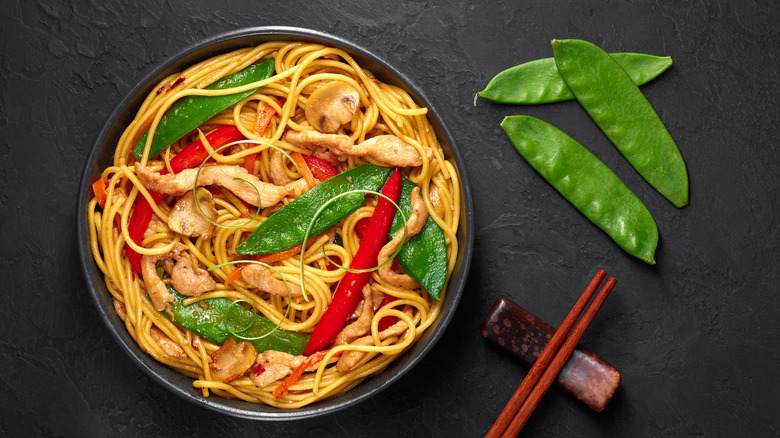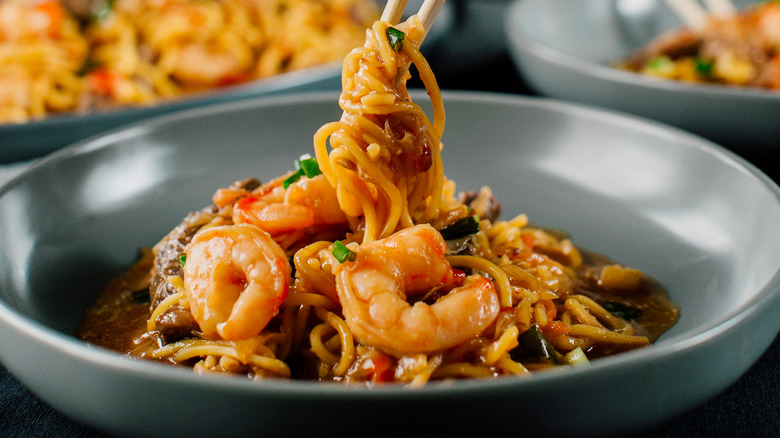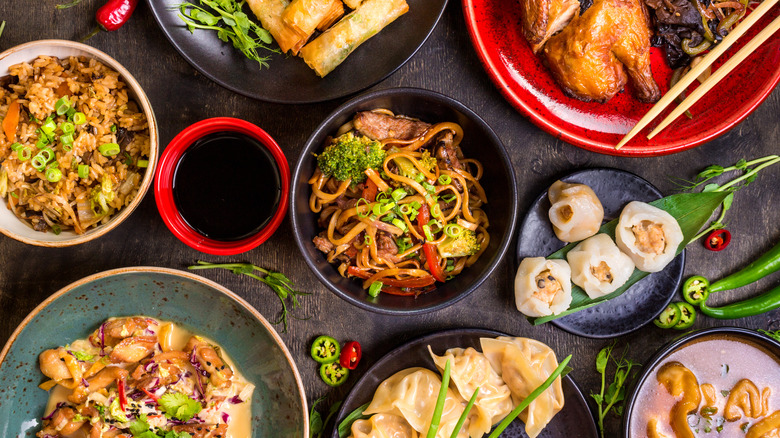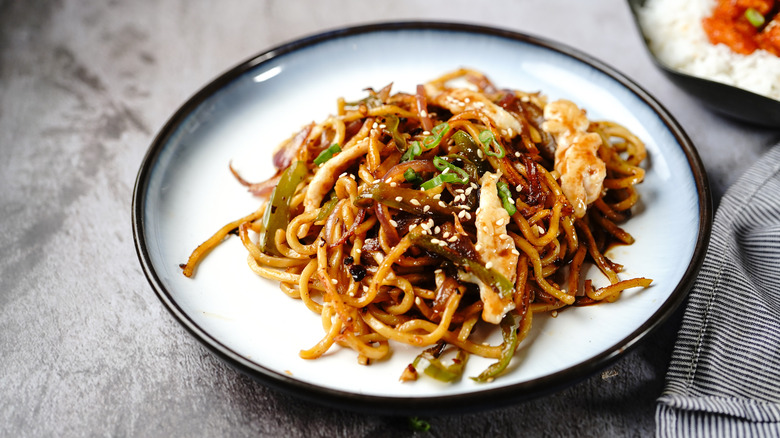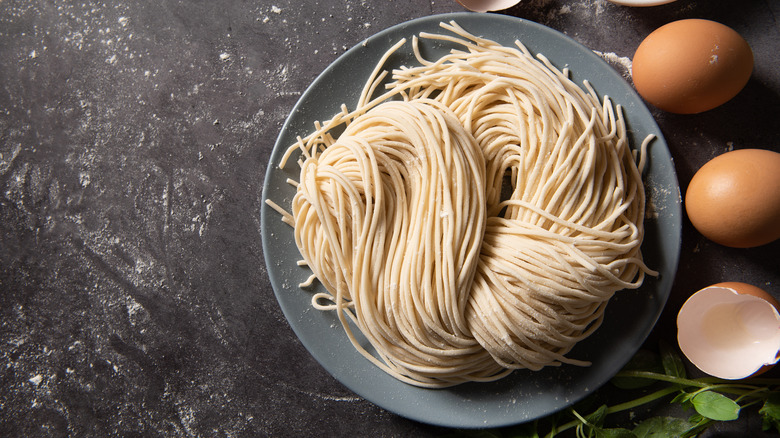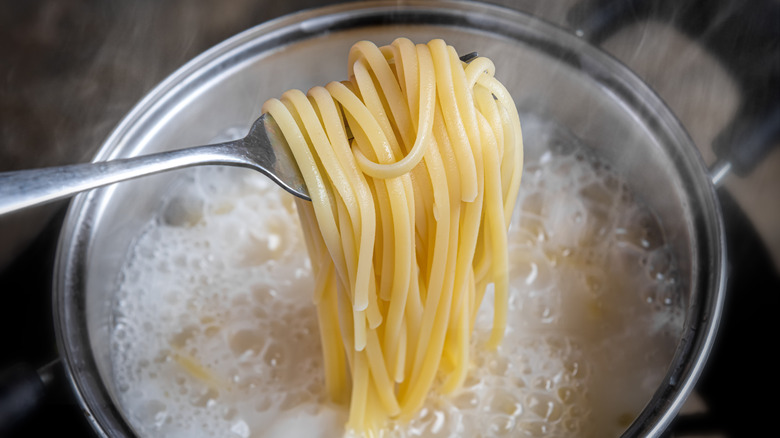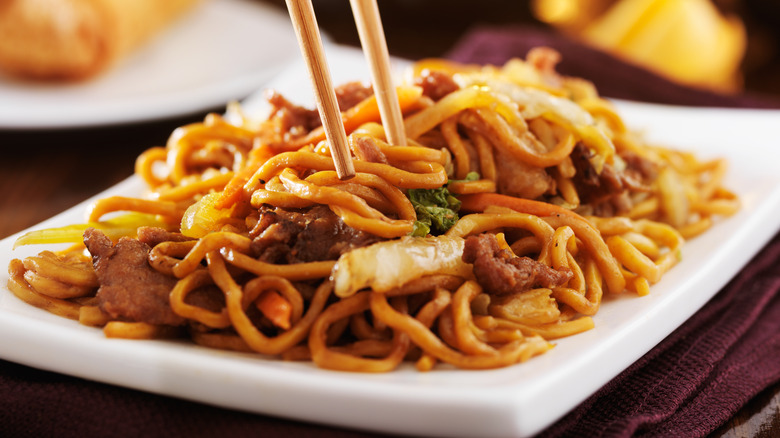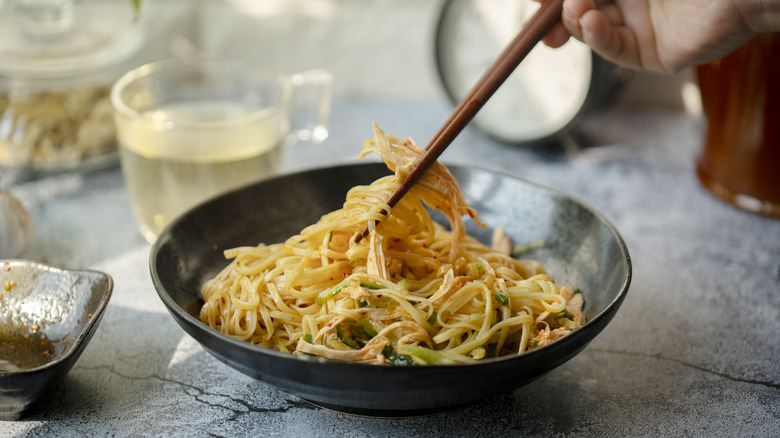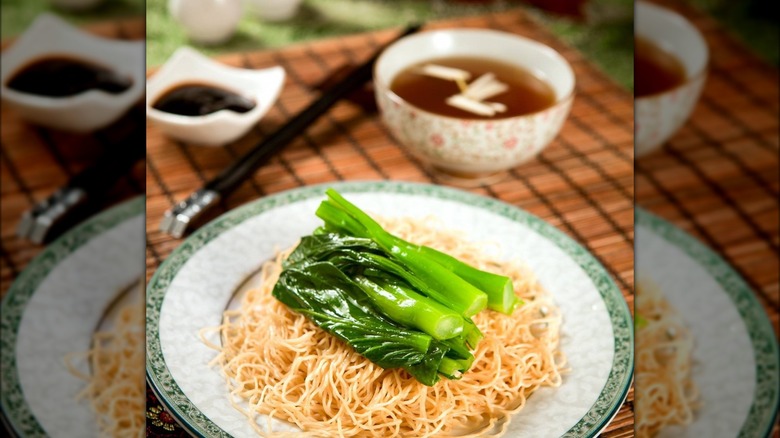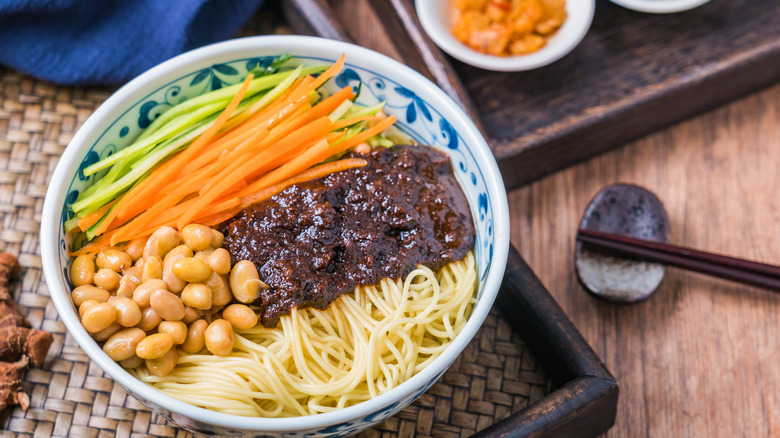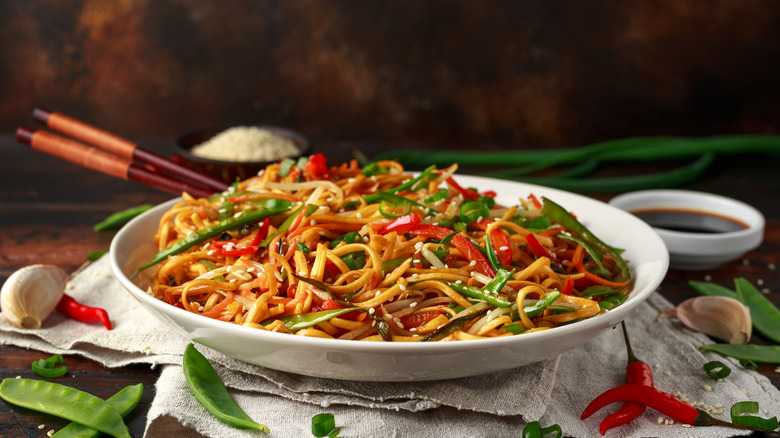Lo Mein: 10 Facts About The Popular Chinese Takeout Dish
It always seems trivial to talk about Chinese cuisine as one unified entity. The country is so vast that it is almost impossible to form a universal idea of Chinese cooking or cite a single dish that embodies the concept of traditional Chinese gastronomy. In addition to its size and regional diversity, Chinese culinary heritage is probably one of the richest in the world. Many dishes have centuries-old traditions and are still relevant despite the powerful foreign influx. Luckily, this diverse gastronomy did not stay confined within its native country. Due to mass migrations, Chinese restaurants started popping up worldwide. This eventually helped Chinese cuisine gain global momentum and international influence.
Besides rice, noodles are unquestionably one of the pillars of Chinese gastronomy. The varieties and the number of noodle-based dishes are seemingly endless, ranging from simple, everyday dishes to elaborate banquet creations. Along with the global expansion of Chinese gastronomy, noodle dishes were one of the easiest to implement and adapt to Western palates. One of the first ones taken internationally was lo mein, a simple, unassuming noodle dish that was ideal, as it could be tweaked and adapted without disrupting its original form.
Though lo mein is a familiar item on Chinese menus in the West, there are many ambiguities about its origin, ingredients, preparation, and serving style. These facts will help better explain how authentic Chinese lo mein became a staple restaurant dish and one of the favorite representatives of American Chinese cuisine.
1. Lo mein is an authentic Chinese dish with ancient origins
The United States is home to many ethnic cuisines, but Chinese and Mexican are the unquestionable American favorites. Though they share evident culinary influence, many staple dishes at Chinese restaurants in the U.S. were crafted on American soil. Classics such as chop suey, crab rangoon, and orange chicken were invented in the U.S., and you will not see them anywhere in China. Unlike these, lo mein has its origins in China. Apparently, it is one of those dishes that originated spontaneously and probably a very long time ago, so it's almost impossible to state the exact time and the place of its origin.
What is certain is that Chinese wheat noodles traditionally used for lo mein have an ancient origin. They date to the Han Dynasty, one of the first dynasties that promoted the formation of Chinese national identity. Chinese wheat noodles were initially produced in Northern China as wheat was the predominant crop in the area, while rice was more prolific in the South. Eventually, the noodles spread throughout the country, which led to the creation of many noodle varieties and different ways to eat them. As lo mein is one of the easiest preparations that essentially only calls for noodles and sauce, it is safe to assume that the combination has long been present in Chinese cuisine, and that it appears in numerous regional variants.
2. Chinese immigrants most likely brought the lo mein tradition in the 19th century
Lo mein is now a typical dish at Chinese American restaurants, and though it is difficult to pinpoint the exact time it was transplanted to the U.S., it probably arrived during the massive Chinese migration to the Americas. This large-scale migration brought many Chinese to the States in the 19th century, and the process continued through the first half of the 20th century. The vast number of migrants, for reasons totally beyond their control, indirectly inspired several bigoted laws intended to restrict and limit the large influx of Chinese immigrants. However, at the beginning of the 20th century, restaurant businesses were exempt from the restrictions. Restaurant owners could travel freely and were also allowed to bring more employees. Naturally, the result was a huge increase in the number of Chinese restaurants in the U.S.
Officially, the first Chinese restaurant in the U.S. was Canton Restaurant, which opened in 1849 in San Francisco. However, the longest-running Chinese establishment is Pekin Noodle Parlor, located in Butte, Montana, which has been in business since 1911. The place was opened by Tam Kwong Yee and the Yow family as a noodle restaurant that catered to the growing Butte community. Pekin's menu reflected Chinese culinary heritage, along with some Americanized favorites, and it apparently also included lo mein, which means that the dish has an impressive background in the U.S.
Apart from noodles, the basement also served as an illegal gambling hub, which probably made the place even more popular.
3. American lo mein is a classic fusion dish
Though lo mein originated in China and was later introduced to the U.S., the American version is usually slightly different from what you will get in China. They both use similar ingredients — the basic recipes call for egg noodles, sauce, vegetables, and optionally some protein — but they differ in the technique and the amount of accompanying sauce.
Even though original lo mein is a sauce-based dish, it tends to be on the drier side. The sauce is usually just mixed with the noodles, which means it will provide enough flavor but will not overpower the other ingredients. On the other hand, the Americanized version will have another approach. The noodles are drenched and completely coated in the heavy, flavor-packed sauce. Sometimes, the dish even leans to the soupy side, leaving plenty of the saucy that the noodles could not soak up. This means that your takeout order in the U.S. will usually have a more robust character dominated by sweet, savory, and salty flavors.
Also, lo mein in the U.S. and many other places outside China is often made as a stir-fry. The technique will involve adding cooked noodles directly to the wok, together with the sauce and the veggies. The short time in the wok will aid caramelization and give the noodles some char. Essentially, American lo mein is a true fusion dish that initially relied on Chinese tradition but has adapted to the Western palates that prefer everything a bit sweeter and saucier.
4. Lo mein always calls for fresh egg noodles
Chinese cuisine has a seemingly endless number of noodle varieties. Apart from the apparent differences in size, shape, and length, they can also be made with different ingredients. Along with soft and tender types made with rice flour, egg noodles — which typically use wheat flour base — are one of the most common options used for soups and stir-fries. They are also the go-to-choice for a classic lo mein.
Though these days you can find noodle packets labeled as lo mein, in reality, there is no such thing as a lo mein noodle. The dish calls for the somewhat universal egg noodles you will easily recognize for their vibrant yellow color. They are usually on the thicker side and relatively long. Apart from those labeled lo mein, you can also look for chow mein noodles, pancit, or those packets simply labeled as egg noodles. Though these egg noodles come in a dry form, for lo mein, the best option is to go with fresh egg noodles.
Whether it's the original or Western-style lo mein, you do not want to process the noodles for too long; they need to stay vigorous and always retain some bite and chew, and these characteristics are best attained with plump fresh noodles. Dry egg noodles can be a replacement if you can't find fresh ones, but perhaps they will not be able to deliver the qualities you are looking for if you want to recreate that classic takeout lo mein.
5. The noodles for lo mein are always cooked separately
There are not many rules when it comes to lo mein. The dish is quite versatile, and most ingredients are subject to change or can be adapted to preference. And though there is no set-in-stone recipe that has to be followed to the letter, there are a few simple steps and requirements that guarantee a successful and perfectly executed lo mein. One includes pre-cooking the noodles before mixing them with the rest of the ingredients. As noodles spend a very short time in the wok — or none at all if you just want to toss them with sauce — they need to be fully cooked separately and be ready to be mixed immediately when the sauce is assembled.
It should be noted that apart from the difference between dry and fresh, the noodles for lo mein can be bought as raw or pre-boiled. The variations are easy to tell as uncooked noodles will have a dusty coating and a completely different texture. It is important always to read the label and the instructions as you do not want to mistake the two varieties. Using raw noodles without boiling them will make your dish firm and sticky; additionally, if you boil the already cooked noodles, the result will be a disappointing, mushy mess. Ready-to-use, pre-cooked noodles need to be heated and refreshed but they only require a quick splash in boiling water.
6. Egg noodles and the sauce are the only constants in lo mein
At its most basic, lo mein is a dish consisting of cooked noodles dressed up with a pungent, flavorful sauce. This means that all other ingredients are variable, and any successful lo mein can essentially only incorporate a batch of fresh noodles doused in a pre-mixed sauce. However, this is rarely how lo mein is served; in most cases, you will see it complemented with veggies or some protein. This versatility is perhaps why lo mein is so appealing and often favored over other Chinese noodle dishes.
Most Chinese restaurants in the U.S. have a customization option that allows guests to add meat — the options usually include chicken, beef, pork, seafood, or tofu for the vegetarian-friendly lo mein. For the indecisive, there is also the combo option that uses a mix of proteins. The veggies often feature broccoli, carrots, cabbage, green beans, mushrooms, or bean sprouts, but the selection varies among restaurants. The sauce, which is traditionally based on soy sauce, or oyster sauce in the more traditional version, can also be tweaked and adjusted to taste. Essentially, lo mein is a versatile dish that wears many hats, and the only thing you can always expect to find in the restaurant-style lo mein are the freshly cooked egg noodles coated in a savory Chinese-style sauce.
7. The name lo mein is a reference to the traditional cooking technique
As you may guess, the term "lo mein" has its roots in the Chinese language. "Mein" or "mian" is the Chinese word for noodles and has already become somewhat standardized on Western menus. "Lo" is a reference to the technique and the preparation. The word stems from Cantonese and can be roughly translated as "mixed" or "tossed." The combination of the words essentially describes the entire philosophy of the dish in which noodles are simply mixed or tossed with the sauce. In Mandarin, the dish is known as "lāo miàn" (laomian), which also refers to the technique and explains how the noodles are prepared. "Mian" is a Mandarin term for noodles, while "lāo" can be phrased as "scoop" (as in the verb, "to scoop"). It is clear that both terms reflect the same idea of scooping boiled noodles and then tossing them with the sauce.
It should be noted that the term "lo mein" is often used loosely in the West. As the dish is so popular and widespread, the order can sometimes result in a dish much different than what you expected or had at other Chinese restaurants. However, you can always be sure that — wherever you are — the lo mein order will always incorporate some type of egg noodles doused in a flavored-packed sauce.
8. Hong Kong-style lo mein is usually served with a soup on the side
Though lo mein and its many variants are eaten across China, the dish is closely associated with Canton (Guangzhou) – which is home to one of eight dominant Chinese cuisines with the strongest international presence. Some Cantonese regional specialties include the succulent char siu and white cut chicken, but lo mein is also a common sight on the menu. As Hong Kong acts somewhat as a hub for Cantonese-style restaurants, it is a place where you can get a very authentic version of lo mein, which does not resemble the fat, glossy, sauce-smothered noodles you typically get in the West.
Lo mein in Hong Kong is a noodle dish, but unlike the thick and chewy noodles used in most American and Western restaurants, the noodles here are thin, resembling angel hair pasta or something you would use inside a soup. Unsurprisingly, the dish is considered a variety of noodle soup, but the broth is served separately. Usually, the order will include a heap of noodles, often topped with greens, while the sauce and the broth are served on the side.
The dish can be eaten in several ways. The broth can be slurped before or after the noodles, but dipping the noodles inside the broth is also acceptable. Of course, optimally, the sauce should be drizzled on top. An additional advantage here is that you can moderate the amount of sauce on your noodles to your liking.
9. Noodles prepared in a similar way are eaten across China
As lo mein is such a universal dish that can take many forms, it is not surprising that variants are found across Chinese territory. In most cases, lo mein is a simple and unpretentious noodle dish complemented with various garnishes that can make a quick lunch or nutritious snack. Apart from its native state, similar tossed noodle dishes are eaten in other Asian countries.
Besides the Cantonese version, a particularly distinctive Chinese lo mein variety comes from the city of Tianjin in North China. Tianjin lo mein is probably the most elaborate version of lo mein you will ever come across. The dish starts with a hefty portion of noodles, then the customers then choose the toppings. The key here is the substantial selection of garnishes and toppings that include fresh or stir-fried veggies, meat, and seafood — and they change depending on the season. The result is a massive portion of noodles with a medley of flavors and different textures.
10. Lo mein and chow mein are two different dishes
Despite common misunderstandings, lo mein and chow mein are two distinctive Chinese dishes. The two share the same origin — they were both invented in China — and use egg noodles as the main ingredient, but they differ in the preparation, which means that the result cannot be the same. This confusion is mainly present outside China as the dishes were sometimes wrongly interpreted and diverged far from the original version. Also, it was often wrongly assumed that the name of the dishes refers to the type of noodles rather than the dish itself.
Chow mein most likely originated in Canton. The Chinese version was lighter and probably used vegetables as a garnish, but when the dish traveled to the States, it attained a different character. Meat became a common garnish, and instead of pan-frying the noodles, restaurants often deep-fried them to achieve a crispy and crunchy texture. These days, chow mein will sometimes come as the deep-fried version, but pan-fried varieties, which are more in line with the original, have also become standard. As explained, lo mein will (or should) be much lighter in profile and spend much less time in the wok. It usually also has more veggies and protein than chow mein.
One of the biggest reasons why many consider lo mein and chow mein to be the same is because many restaurants wrongly use the terms to denote any noodle-based dish on the menu, regardless of the preparation method or the ingredients.
